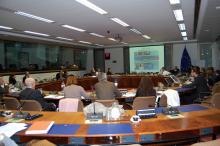The first results are in from a Europe-wide initiative to protect workers from respiratory crystalline silica, Lisa Russell reports
As respirable dust, silica can penetrate deep into the lungs and silicosis is a well known health hazard when inhaled
There is no getting away from silica thanks to its abundance in the earth's crust and its role as an essential ingredient in all kinds of objects from bricks and mortar to glasses and pots. But workers who inhale fine dust that contains respirable crystalline silica (RCS) are at risk from lung damage and the issue is of concern in workplaces as diverse as quarries and foundries.
The good news is that the exposure can be controlled. Key industries where RCS is an issue recognised its importance by signing in 2006 an EU-wide social dialogue agreement whose cornerstone is a risk-assessment procedure to help determine which measures and good practices should be applied in order to improve a worker's protection (October 2007).
The agreement included the introduction of a reporting system to establish the numbers at risk and the measures that are undertaken at each workplace. "This whole issue is about looking after people's occupational health," said Martin Isles, who chairs the
The first round of the quantitative reporting exercise took place last year and indicates potential exposure to RCS for more than 40% of people working across all the locations within the agreement's scope. The performance of individual sectors and countries has not yet been identified, although the intention is that by June this year a way will have been found to present the information while respecting confidentiality requirements. The report also gives the first feel for a number of key performance indicators, showing that there is some way to go before all workers are aware of the guidance that has been produced under the initiative, but that a high percentage are already covered by risk assessment. Reporting will continue every two years, the next round being in 2010.
The reporting process goes far beyond a statement of current practice: it is designed to bring about cultural change and behavioural change. "It has had a big effect in the UK and I'm sure it has in other countries as well by raising awareness of this issue," said Isles. It is leading to increased use of protective measures. "We want people to know why they need to protect themselves," he added. They should also have the confidence to speak out if colleagues are putting themselves at risk.
Silica refers to a group of minerals composed of silicon and oxygen, the two most abundant elements in the earth's crust. It is found in many forms, including quartz. Levels of free crystalline silica in minerals vary - for instance, typically greater than 90% in sand and sandstone and up to 30% in granite. As respirable dust, it can penetrate deep into the lungs and silicosis is a well known health hazard when inhaled. Severity varies, but the scarring caused in the inner parts of the lungs can lead to breathing difficulties and even death. It has also been found that the relative lung cancer risk is increased in people with silicosis.
Occupational exposure can occur in any workplace where there is airborne dust that contains a proportion of RCS. Exposure does not only come through activities that create visible clouds of dust, such as cutting and blasting, stressed Isles. "Just because you can't see it doesn't mean that it is safe," he said. For instance, people getting in and out of an excavator cab many times a day may bring in mud on their boots and the air conditioning may simply circulate the dust.
The agreement - officially called the 'European multi-sectoral social dialogue agreement on workers' health protection through the good handling and use of crystalline silica and products containing it' - was signed by representatives of 14 industries. Social dialogue agreements bring together European-level trade associations and trade unions. The signatories of the RCS agreement therefore include UEPG,
Social dialogue agreements provide an alternative route to seeking legislation - and one that is much quicker to implement - but do not supplant European and national regulations and exposure limits. "The agreement has achieved a huge increase in awareness of silica," said Isles.
A key document produced as an annex to the agreement is a good practice guide, which explains how to carry out risk assessment and health surveillance, and outlines specific measures. Dozens of straightforward task sheets have been produced. General guidance sheets applicable to all sectors explain issues such as cleaning and dust monitoring while specific task sheets focus on more specialised activities such as the crushing, drying and grinding of minerals and the use in quarries of mobile plant for excavation and haulage.
An online system facilitated the form-filling and data consolidation for the reporting that is at the heart of the agreement's application. The forms were made available in 22 languages and complete data was reported for 4,707 work sites, including 121 that did so on a voluntary basis as they were outside the agreement's current scope.
The reporting represented a total of 428,698 employees of whom 173,239, or 40.4%, were estimated to be potentially exposed to RCS. Among those potentially exposed, a high percentage (88%) were covered by risk assessment, and 62% by exposure monitoring.
More than 64,600 (37%) of those potentially exposed had been assessed as requiring health surveillance for silicosis. Of these, 89% were reported as effectively covered by surveillance. There are differing views best surveillance method and it would be helpful if these can be focused into one view that is supported by science, said Isles.
The reporting showed that 74% of people potentially exposed received information, instruction and training on the general principles of prevention. One of the areas that gave the greatest scope for improvement was the number of people who were using the task sheets in the good practice guide, said Isles. The results found that just 44% were covered so far.
Most sites - 70% - apply technical measures to reduce the generation and dispersion of fine particles at source. Organisational measures are in use on 59% of sites and personal protective equipment is distributed and used on 78%.
In the UK, the
A relevant study has also recently been published in the UK by the Health & Safety Laboratory for the Health & Safety Executive. 'RR689 - Silica baseline survey silica' examined employee exposures and the control of RCS in four UK industry sectors, including quarrying. RCS exposure was generally adequately controlled in quarries, it said. Large quarry groupings were well-equipped in terms of health and safety expertise, but exposure control regimes failed if neglected.
Silica might in due course be brought into the Carcinogens Directive when the substances that are included are reviewed. But the important thing is
that action has been taken already, said Isles. "The view we take is that the agreement is demonstrably protecting people now."









